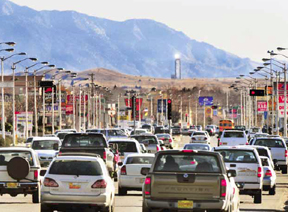
Next time you visit the gas station and fill your tank with $3.30 a gallon gasoline, reflect on this. Nine years ago you could have bought that same gas for 98 cents a gallon.
What is going on?
Sandia’s chief economist Arnie Baker (0320) says quite a lot, actually.
From a declining US dollar to restricted oil production in the Middle East, Russia, and Venezuela to increased oil demand by China and India, the price of gasoline and oil is on a seemingly endless upward spiral.
Last month natural crude oil hit $110 a barrel, compared to an average $72 a barrel in 2007. And just 10 years ago oil prices were at $14.80 a barrel in inflation-adjusted dollars.
Rising demand
Arnie says that at the top of the list of reasons for the high prices is a larger than expected demand for oil in industrialized countries and China’s rapidly expanding economy. The US consumed the most oil — 20.6 million barrels per day in 2006 — but China is playing a quick catch-up at 7.3. Other countries consuming large amounts of oil are Japan at 5.2, Russia at 3.1, Germany at 2.6, and India at 2.5 million barrels a day. The world as a whole consumes 86 million barrels a day and 31 billion barrels a year.
“The world economy has been growing at a pretty good clip,” Arnie says. “As a result, oil demand has remained high in the oil-hungry United States while it has been increasing sharply in developing countries like China and India.”
In February alone oil demand by China rose 6.2 percent, exceeding the 3.3 percent rise in January and the 3.5 percent increase for all of 2007. Also during February 2008, China increased its purchases of crude oil by 18.1 percent compared to a year earlier.
Stagnant oil production
At the same time the thirst for oil is on the rise, Organization of the Petroleum Exporting Countries (OPEC) and other oil producing nations are not increasing their output as much as they otherwise might, largely because they don’t need to. Rising oil prices have poured billions of dollars into their economies and reduced their need to produce more oil, Arnie says.
The only OPEC country that has agreed to significantly increase its oil production capacity is Saudi Arabia, but that process is taking longer than anticipated. Instability in other countries in the region, such as Iraq, is causing stagnant production levels, and Russian production, while still increasing, is less than it would have been if President Vladimir Putin had not reasserted control over that country’s oil and natural gas sector. Venezuelan President Hugo Chavez has “redirected” the national oil company PDVSA, disrupting what would have otherwise been higher levels of Venezuelan oil production.
“OPEC, especially Saudi Arabia, Kuwait, and the UAE [United Arab Emirates], acts as a balance wheel in the oil market through their surplus oil production capacity, which began to decline in 2003. By 2005 it was down to 1 million barrels a day, though it rose to 2.2 million barrels a day last year,” Arnie says. “When the ability to produce extra oil is low, any disturbances in the market — like instability in Nigeria, the war in Iraq, or problems with Iran over nuclear power — cause prices to rise. While excess capacity is expected to fall this year, it may grow to 3.6 in 2009 and begin to provide the market with some breathing room.”
Falling dollar
A third thread to the oil price increase is the falling US dollar, which is very low against other major currencies. During the first three months of this year, the euro rose 7.5 percent against the dollar. The dollar also tumbled 10.5 percent versus the yen.
Since oil is priced globally in dollars, any big markdown in the dollar gives oil exporters incentives to try to charge higher dollar oil prices. It also affects the US and its trading partners differently. For foreign buyers, whose currency is rising in value against the dollar, the effect of any oil price increases is much less. But American consumers have to pay 100 percent of any oil price increase with their dollars.
China can afford $100 a barrel oil
China is an example. That country’s currency is rising in value, but it still can sell its wares overseas cheaply — and it sells a lot. As a result, China has a huge financial reserve and can afford $100-a-barrel oil.
As the dollar’s value slips, the stock market gets more and more “nervous,” Arnie says, causing people to move speculative money from stocks into commodities such as oil, metals, livestock, corn, and soybeans. The new speculative money pushes the commodity prices higher. “All this helped oil prices leap to $110,” he says.
Arnie cites one more reason for pain at the pump — not enough US oil refining capacity. Existing refineries in the US produce gasoline and other end-use products in the 90 percent plus range of capacity. While refining capacity has crept up a small amount since 2005 through operating efficiencies, the solution — adding significant refinery capacity — is more easily said than done. People don’t want to live near refineries, and refineries are subject to tight environmental restrictions. No new refinery has been built in the US since 1976. The lack of enough refineries is being made up for by imported products such as gasoline and other refined products — averaging about 13.4 million barrels per day in 2007.
“These reasons and more have led to the increase in oil prices,” Arnie says. “Some oil analysts believe that between 2009 and 2011 prices will return to the 80 dollars a barrel level or below. Others think prices will remain in the $90 range or above. To me it’s a big toss-up right now, but markets eventually work, and not only on the way up.” .